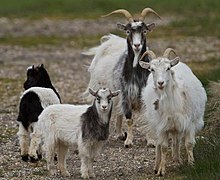 In Mýrasýsla county In Mýrasýsla county | |
| Country of origin | Iceland |
|---|---|
| Use | meat, milk |
| Traits | |
| Coat | white |
| Face color | white |
| Horn status | horned in both sexes |
| |
The Icelandic goat (Icelandic: íslenska geitin [ˈistlɛnska ˈceiːtɪn]), also known as the 'settlement goat' (Capra hircus), is an ancient breed of domestic goat believed to be of Norwegian origin and dating back to the settlement of Iceland over 1100 years ago. This breed of goat was on the verge of extinction during the late 19th century, but recovered prior to World War II, only to precipitously decline again. The population has dropped below 100 animals several times, leading to genetic bottleneck. As of 2003, there were 348 goats in 48 flocks distributed throughout most parts of Iceland. At the end of 2012, the herd had increased to 849. Since this breed has been isolated for centuries, the Icelandic populations are highly inbred. The Icelandic goat is very rare outside its native land. Under its coarse, long guard hair, the Icelandic goat has a coat of high quality cashmere fiber. Icelandic goats are kept mainly as pets and their economic potential for meat, milk, cashmere and skin production remains to be explored. The Icelandic goat is currently of little economic value.
The Icelandic goat is the only farm animal sponsored by the Icelandic government for the purpose of ensuring its survival. In 2014, the annual grant was ISK 4,200 (36 US dollars) per goat, for a maximum of 20 goats, down from ISK 6,500 (56 US dollars) per goat in 2010, contingent upon the owner submitting a report on each animal. Farmer Jóhanna Bergmann Þorvaldsdóttir has been breeding the Icelandic goat, hoping to prevent extinction.
See also
- Norwegian Elkhound
- Norwegian Lundehund
- Norwegian Forest Cat
- Norwegian sheep landrace
- Norwegian chicken landrace
- Icelandic cattle
- Icelandic Chicken
- Icelandic Horse
- Icelandic sheep
- Icelandic Sheepdog
References
- Porter, Valerie; Alderson, Lawrence; Hall, Stephen J.G.; Sponenberg, D. Phillip (9 March 2016). Masons World Encyclopedia of Livestock Breeds and Breeding : 2 volume Pack. p. 374. ISBN 9781845934668. OCLC 958946719.
- Baldursdottir, B.K.; Kristjansson, T.; Hallsson, J.H. (June 2012). "Diversity of the Icelandic goat breed assessed using population data". Acta Agriculturae Scandinavica, Section A - Animal Science. 62 (2): 53–65. doi:10.1080/09064702.2012.723737. Retrieved 18 March 2023.
- ^ "The Icelandic Goat Breed, Icelandic Sheep Breeders of North America". Isbona.com. 1994-07-08. Archived from the original on 2012-07-18. Retrieved 2014-01-08.
- ^ Atvinnu- og nýsköpunarráðuneytið (2014). ""Niðurstöður starfshóps um málefni íslenska geitfjárstofnsins" (Conclusions of the Working Group on the Icelandic Goat Breed)" (PDF). www.atvinnuvegaraduneyti.is. p. 2. Retrieved 2015-11-24.
- Porter, Valerie, 1942- (1996). Goats of the world. Farming Press. pp. 25–26. ISBN 0852363478. OCLC 36260544.
{{cite book}}: CS1 maint: multiple names: authors list (link) CS1 maint: numeric names: authors list (link) - "Daily Life - Last Chance to See…; The Icelandic Goat (ESA), Iceland Review Online, 15 October 2010". Archived from the original on 17 December 2012. Retrieved 1 August 2011.
- Dunsmith, Gabriel (5 April 2017). "Outside Of Reykjavík: Mountains, Sagas And... Goats". The Reykjavík Grapevine. Retrieved 3 November 2017.
External links
- The Icelandic Goat Breed, Icelandic Sheep Breeders of North America
- Icelandic goats, Erfðanefnd landbúnaðarins
- The Iceland goat: past and present, The Farmers Association of Iceland
| Animal breeds of Iceland | |
|---|---|
|